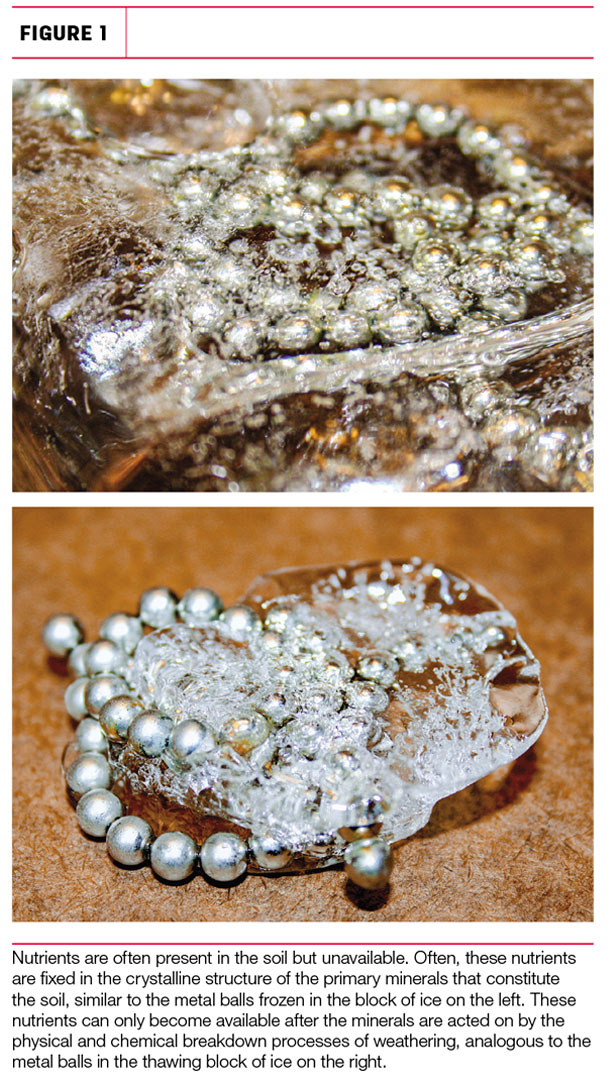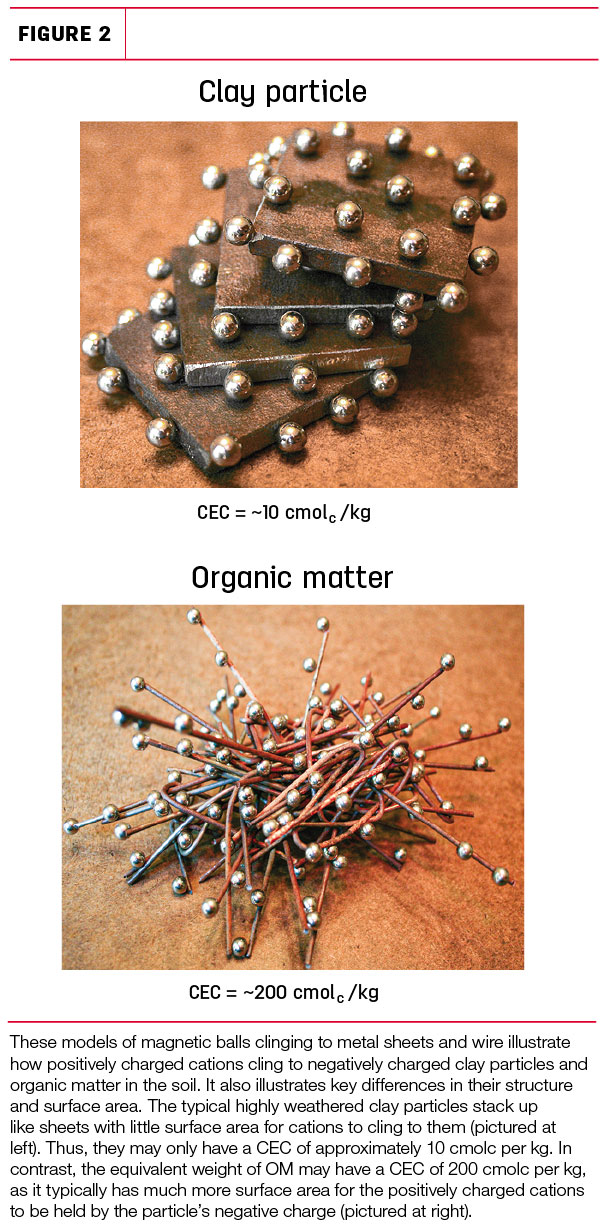On the first day in soil science class, we teach that soil is definitely not the same as dirt. Dirt has no value. That’s why your momma fussed at you about tracking it in her house. But soil has value.
In fact, some of the most valuable assets on any farm are the nutrients found in the soil. So how are these assets held in the soil?
Plant growth requires the presence of 16 essential nutrients (some argue it is 17). The three most abundant nutrients in plants are carbon (C), oxygen (O) and hydrogen (H), but these are brought into the plant from the air and water which is absorbed. The other 13 essential nutrients are taken up from the soil.
It is helpful to think of nutrients in the soil as a portfolio of assets. Like any portfolio, these assets are present and held in a variety of ways. Some of those assets are fixed and not freely available. For example, many of the nutrients in the soil are found within the primary minerals, parent material and structural framework of the soil (Figure 1).

These nutrients are, from a practical standpoint, unavailable to the plant. These would be analogous to fixed assets like buildings or land, which are valuable but are not readily available for day-to-day transactions. These nutrients would have to be subjected to weathering (a process of physical and chemical breakdown) in order to be made available to the plant. This is a very slow process.
Nutrients may also be in the soil in organic compounds (e.g., plant residues, animal manures, microorganisms, etc.) which are not available to the plant. These nutrients must be mineralized to become plant-available.
Mineralization is the process of releasing essential nutrients from organic compounds. This is the final step in decomposition and is made possible by microbes in the soil. Nutrients bound in organic compounds are assets which are more easily converted than the aforementioned weathered minerals.
As these nutrients can be available over time, they are analogous to bonds and CDs (certificates of deposit) which one may have as part of their financial portfolio.
Once they are weathered or mineralized, nutrients are held in the soil by being adsorbed on the surface of particles of clay, silt or sand, or on the organic fraction of the soil. These nutrients are stuck on these soil particles, much like magnets on a refrigerator. These nutrients are available to the plant. To extend the analogy on financial assets, these nutrients are like the available balance in one’s checking or savings account.
Many of the nutrients absorbed by plant roots exist as ions. Ions are elements or compounds containing nutrients which carry a charge. Many of the 16 essential nutrients are available to plants only in forms which have a positive charge to them (e.g., K+, Ca2+, Mg2+, Zn2+, Cu2+, etc.).
These positively charged ions are called cations, and they are held by the negative charge of the sand, silt, clay and organic matter (OM) particles in the soil. In fact, the nutrient-holding capacity of the soil is measured by determining the number of cations the soil can hold. This is known as the cation exchange capacity (CEC) of the soil.
The CEC capacity is largely influenced by the soil type, texture (i.e., the percent sand, silt and clay), pH, and OM content of the soil (Figure 2).

The types of clay differ in their CEC. Some clay types have high CEC levels, with 100 cmol of charge (cmolc) per kilogram or more being fairly common. In contrast, those clay types in highly weathered soil, such as in the southeastern U.S., will typically have very low CEC. Those clay types typically have 10-20 cmolc per kilogram. Even if soils are low in CEC, good management can promote greater soil fertility and health.
Two keys to promoting greater soil health and fertility are increasing soil OM levels as much as possible and maintaining a near-neutral soil pH. Soil OM generally has a much greater capacity to hold nutrients than other soil particles, since OM typically has a CEC of 200 cmolc per kilogram. Plus, increasing soil OM increases the rate of nutrient cycling.
The microorganisms in the OM bind (immobilization) and release (mineralization) nutrients. As a rule of thumb, every 1% of soil OM will release 20 to 30 pounds of N, 4.5 to 6 pounds of P2O5, 10 to 40 pounds of K2O, and 2 to 3 pounds of S per acre over the course of each year. Because this release is dependent upon biological activity, most of these nutrients will be released in warm weather (i.e., spring and summer) when the microbes are most active.
Ensuring soil pH is in the optimum range for the crops being grown is critical to ensure crop growth is maximized. Keeping an optimum soil pH will ensure soil tilth is maintained and root development is encouraged. But a near-neutral pH is also crucial to ensure all of the negative charges on the soil particles are attracting desirable cations (K+, Ca2+, Mg2+, Zn2+, Cu2+, etc.) instead of undesirable ones (e.g., H+ and Al3+). A near-neutral pH is also crucial to enabling the microorganisms which live in the soil to help make nutrients in the soil available to the plants.
Like any investment portfolio, the key is to manage the nutrients so the investment yields a return. If one’s soil is high in CEC, the key is maintaining a good soil pH. But if the soil is low in CEC, one needs to ensure the management practices being used promote an improvement in the soil OM as well as maintain a near-neutral pH.










